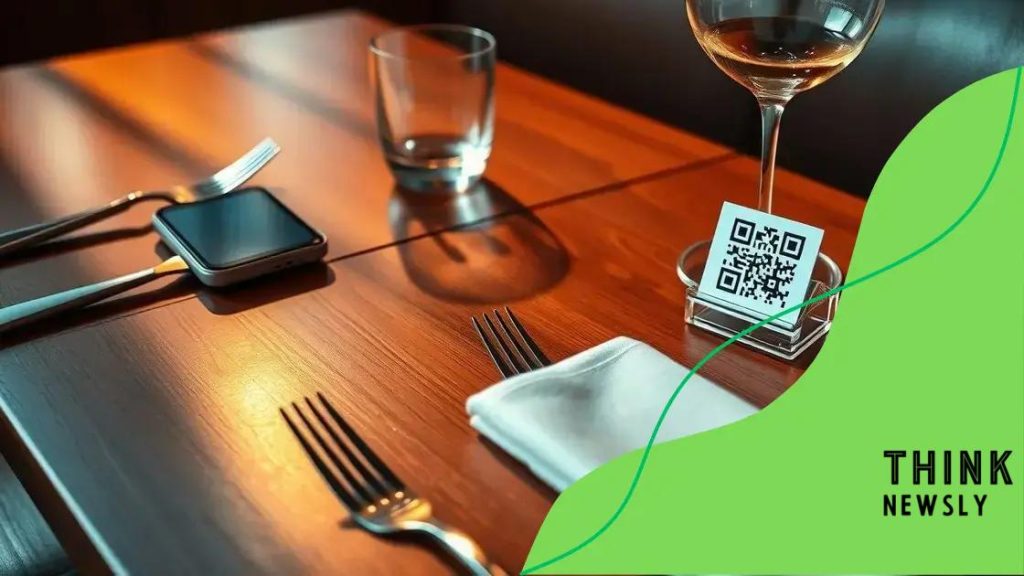Contactless tipping becomes common: What you need to know

Anúncios
Contactless tipping simplifies how customers show appreciation for service, offering convenience and safety through digital payment methods while ensuring fairness in tip distribution for staff.
Contactless tipping becomes common across various service industries, transforming how we show appreciation. Ever thought of how this change influences your dining experience? Let’s dive into it.
Anúncios
Understanding contactless tipping
Understanding contactless tipping is essential in today’s fast-paced service industry. This modern method allows customers to show appreciation without the hassle of cash. It’s not just convenient; it’s also safer.
What is Contactless Tipping?
Contactless tipping uses technology like smartphones or NFC (Near Field Communication) devices. This method lets patrons tip their servers quickly and easily. Imagine enjoying a meal and simply tapping your phone to add a tip! It’s that simple.
Why It Matters
Over recent years, many venues have called for a shift towards these technologies. People want more convenient ways to interact with their favorite places. Contactless tipping supports these new expectations.
Anúncios
- Speed: Complete transactions faster and more smoothly.
- Hygiene: Reduce physical contact, supporting health safety.
- Accessibility: Provides an easy option for everyone to tip when they wish.
Besides convenience, contactless tipping has numerous benefits for the service industry as well. It can equalize tips among staff, ensuring a better distribution of rewards. Additionally, businesses receive instant feedback on service quality when customers use these features frequently.
Popular Trends
As this method gains popularity, several trends emerge. Many restaurants now encourage customers to leave feedback via the same apps they use to tip. This creates a seamless experience for users. Furthermore, loyalty programs often integrate with contactless tipping. Customers can earn rewards while tipping, making their outings even more enjoyable.
Overall, understanding the essence of contactless tipping helps both customers and businesses thrive in a tech-savvy world. Embracing this change means better experiences for everyone involved.
Benefits of contactless tipping for customers
Benefits of contactless tipping for customers are becoming increasingly evident as more people experience this convenient payment method. It simplifies the way we show appreciation without needing cash or change. This new trend reflects a shift toward modern payment solutions, making it easier than ever for customers to tip.
Convenience at Your Fingertips
With contactless tipping, customers can quickly add a tip with just a tap on their smartphones. This method eliminates the need to fumble for cash or worry about small bills. Imagine enjoying your favorite meal and being able to tip in seconds while still at the table!
- Fast transactions allow for smooth experiences.
- No need for cash on hand.
- Customers can easily adjust tip amounts based on service quality.
Another important benefit is the enhanced hygiene. In a world where cleanliness matters, contactless tipping reduces physical interactions. Customers can feel more at ease knowing they can show their appreciation without direct contact.
Flexibility and Options
Furthermore, contactless tipping provides greater flexibility. Many restaurants allow customers to choose their desired tip amount through user-friendly apps. Some even give options to tip multiple personnel, ensuring that everyone’s contribution is recognized.
This technology can also enhance the overall dining experience. Customers often feel more in control when they can adjust their tips based on their satisfaction level. It encourages excellent service, as staff are motivated to provide exceptional experiences to earn better tips.
In short, the benefits of contactless tipping for customers are vast. This modern solution brings convenience, hygiene, and flexibility, transforming how patrons show appreciation in service settings.
Impact on the service industry

Impact on the service industry is significant as contactless tipping becomes a norm. This transition affects how businesses operate and interact with customers. It shifts the dynamics of tipping, bringing both challenges and opportunities.
Changes in Revenue Distribution
One major impact is on how tips are distributed among staff. Traditional tipping often led to uneven rewards, especially in team settings. With contactless tipping, it becomes easier to distribute tips fairly through pooled options. This helps ensure everyone who contributes receives recognition.
- Encourages teamwork among staff members.
- Reduces competition among individuals for tips.
- Promotes a positive work environment.
As the service industry adapts, many businesses are starting to see improved customer satisfaction. When patrons can tip easily, they often feel more inclined to reward excellent service. This motivates staff to enhance their performance, leading to a better experience for everyone involved.
Data Insights
Another critical impact is the collection of valuable data. Many digital tipping platforms allow businesses to analyze tipping patterns. This data can provide insights into customer preferences and service quality. By understanding these trends, businesses can adjust their strategies and improve their offerings.
Moreover, technology plays a crucial role in charging experiences. Staff who can quickly adapt to digital solutions create a more modern and attractive ambiance for customers. The smoother processes can enhance overall dining experiences, whether at a restaurant, bar, or hotel.
The impact of contactless tipping on the service industry is vast. It creates an evolving landscape that requires us to rethink best practices for tipping and customer service.
How businesses are implementing contactless tipping
How businesses are implementing contactless tipping reflects a significant shift in customer service practices. Many establishments are adopting this innovative approach, and the results are promising. By integrating technology into their operations, businesses can enhance customer satisfaction while simplifying the tipping process.
Adopting Technology
To begin, businesses need to choose the right technology platform. Many restaurants and bars are utilizing mobile payment applications that allow for seamless tipping. These platforms often come with features like QR codes or NFC capabilities, making it easy for customers to tap and tip without hassle.
- QR code-based tipping allows patrons to scan and tip directly from their smartphones.
- NFC technology lets customers use contactless credit or debit cards.
- Apps can track tips and distribute them among staff automatically.
Moreover, staff training is another essential aspect of successful implementation. Employees must understand how to use these new systems effectively. Comprehensive training ensures that both staff and customers feel comfortable using contactless tipping options. Transparent communication about how these systems work can help reduce any confusion.
Incorporating Feedback
Additionally, savvy businesses actively seek customer feedback about their experiences with contactless tipping. This feedback can provide valuable insights into what works well and what might need adjustment. Establishments can use surveys or directly ask customers how they found the new tipping method. This openness can foster a sense of trust and engagement.
Many businesses are also combining contactless tipping with loyalty programs. By allowing customers to earn rewards while they tip, they create added value. This integration can keep customers returning, knowing they can enjoy benefits while supporting their favorite staff.
In summary, the implementation of contactless tipping in businesses requires thoughtful planning and a willingness to adapt. As more establishments learn to incorporate these innovative tipping solutions, they pave the way for improved service and customer satisfaction.
Potential challenges and solutions
Potential challenges and solutions related to contactless tipping have emerged as businesses adapt to new technologies. While this method offers numerous benefits, there are hurdles that both customers and businesses must address. Identifying these challenges allows for better implementation strategies.
Integration Issues
One common challenge is the integration of new tipping systems into existing payment methods. Some businesses may find it difficult to setup without proper training. Customers might also struggle if they are unfamiliar with the technology being used. Providing clear instructions on how contactless tipping works can help ease this transition for everyone involved.
- Offer staff training on technology use.
- Provide visual guides for customers at tables.
- Choose user-friendly platforms that are easy to navigate.
Moreover, not all customers may have smartphones or digital payment options. This can create a barrier for those who prefer using cash or traditional cards. To combat this, businesses can keep cash tipping options available, allowing all customers to participate in the tipping process without feeling excluded.
Privacy and Security Concerns
Another significant concern is privacy and security. Many customers worry about sharing their payment information online. This can limit the adoption of contactless tipping methods. Keeping the payment process secure is essential in building trust.
Implementing encryption and secure payment methods can help alleviate these fears. Additionally, communicating the steps taken to protect customers’ data will build confidence and encourage more people to use contactless tipping.
In conclusion, the challenges of contactless tipping require businesses to anticipate and address potential issues. By providing adequate training, ensuring privacy and security, and maintaining inclusive tipping options, establishments can successfully navigate the transition to contactless tipping.
FAQ – Frequently Asked Questions about Contactless Tipping
What is contactless tipping?
Contactless tipping allows customers to give tips without using cash, usually through mobile apps or devices that accept digital payments.
How does contactless tipping improve the customer experience?
It makes tipping quicker and more convenient, allowing customers to show appreciation easily and reducing the need for cash handling.
Are there any security concerns with contactless tipping?
Yes, some customers may worry about their payment information being shared. However, using secure platforms can help protect their data.
How can businesses successfully implement contactless tipping?
Businesses can integrate user-friendly technology, train staff adequately, and keep cash options available for those who prefer traditional tipping.





